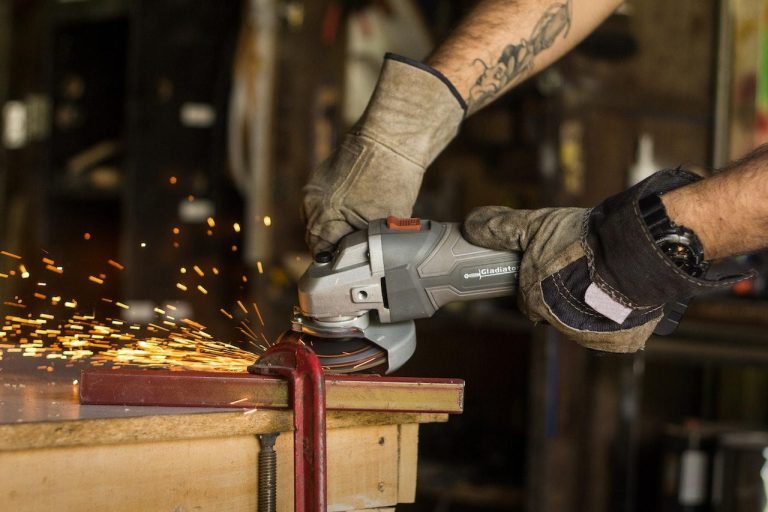Whether you are a professional in metalworking, masonry, or carpeting or just like to work on various home projects, an angle grinder is one of the most important tools you should have in your toolbox.
An angle driver has several purposes.
- Cutting metal, stone, tile, ceramic, wood, and brick. It is preferred to saws because they are easy to maneuver.
- Grinding to remove any excess materials quickly and efficiently.
- Polishing, finishing, or smoothing out metal, wood, and stone.
How to Choose an Angle Grinder
Most, if not all picks for the top angle grinders all focus on the factors we shall discuss in this guide.
Type of grinder
There are three main types of angle grinders:
- Pneumatic grinders. Pneumatic grinders use compressed air to run their motors.
- Electric grinders. These grinders have a motor that works when connected to a power source using a power cord.
- Cordless grinders. Cordless grinders are battery-powered grinders that are easy to move around with.
Type of Disc/Wheel
When dealing with angle grinders, the terms disc and wheel are used interchangeably. Though grinders come with discs, you can purchase different discs according to what you want to use them for. When doing this, ensure the discs fit the grinder.
There are different types of disc:
- Wire discs. A wire disc is a circular based disc that comes in different sizes. A wire disc with twisted brushes works more efficiently when compared with wire discs with thinner straight bristles. Wire discs are preferred for paint and rust removal and metal polishing tools.
- Grinding discs. Grinding discs are the most commonly used discs in angle grinders. Also called grit discs, grinding discs are used for grinding metal and stone, removing extra material from a surface, and preparing metal cuts for welding. Grinding discs have grains and a bonding agent that form the grit. This grit determines how abrasive the disc will be.
- Flap discs. Flap discs are used to smooth surfaces and have softer surfaces. They also come with different grits, and just like grinding discs, the softer the surface, the higher the grits. Other than polishing surfaces, flap discs are used to remove burrs and scratches from metal surfaces.
- Diamond cutting discs. These discs are used to cut granite and other hard materials. This is because they have diamonds on the edges. They also have a cutting rim that makes them last longer.
- Cut-off discs. Cut-off discs are also called parting discs and are used for cutting metal sheets and metal bars. They are typically thinner. The thinner the disc, the more precise the cut. Unfortunately, thinner discs break easily. Cut-off discs need to be handled with care to avoid potential accidents.
- Wood discs. As the name suggests, wood discs are used to work on different types of wood.
Disc Diameter
The diameter of a disc also comes into play when choosing an angle grinder. There is a wide variety of disc diameters averagely, ranging from 4 inches to 9 inches. A disc with a larger diameter cuts deeper. Smaller discs are great for small projects but wear faster.
Motor Power
Motor power is measured in Watts. The power needed depends on the size of the disc. The higher the wattage, the more power the grinder has. This means that it can cut through thicker materials.
Another factor to look at is the input level, which will be measured in amps for electric grinders and cubic feet per meter(CFM) for pneumatic angle grinders.
Size
Angle grinders are differently sized:
- Small angle grinders. Small grinders can take discs 7 inches and smaller. Smaller grinders are preferred for DIY projects as they are easier to manage. Most small grinders have brushless motors to make them more efficient and durable.
- Middle-angle grinders. These are angle grinders that take 7-inch discs and have a motor with three horsepower.
- Large angle grinders.Larger angle grinders, on the other hand, are best for heavy-duty projects as they can work on thicker materials. Large angle grinders have motors with a capacity of 5 horsepower.
Speed Ratings
Speed ratings in discs are measured in RPM. You can find the maximum rotating speeds on the disc. Smaller discs rotate faster than larger discs. They can make up to 10,000 rotations per minute, while larger ones only do 6,000. Nonetheless, larger grinders still pack on more power.
Safety Features
When looking at angle grinders, it is important to check for certain features, such as:
- Anti-kickback. Kickback happens when your grinder jams on material as you work on it. The anti-kickback feature shuts off the grinder when this happens.
- Restart protection. This feature prevents an angle grinder from automatically restarting if it overheats or loses power connection.
- Slow start. A slow start prevents an angle grinder from starting at full speed when powered on.
- Paddle switch. A paddle switch or deadman’s switch is a safety feature in grinders that allows you to control the on/off switch. This means that the grinder will stop when the switch is released.
Conclusion
Choosing an angle grinder can be confusing, especially if this is your first time getting one. Hopefully, with this guide, making the decision will be easier. With the right-angle grinder, there is nothing you cannot do.

